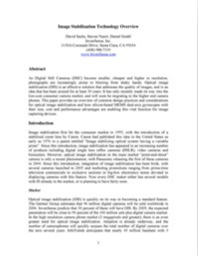Descripción general de la tecnología de estabilización de imágenes
La estabilización de imágenes ópticas (OIS) aborda la calidad de las imágenes, y es una idea que ha existido durante al menos 30 años. Recientemente ha llegado al mercado de cámaras de consumo de bajo costo, y pronto migrará a los teléfonos con cámara de extremo superior. Este documento proporciona una visión general de las prácticas y consideraciones de diseño comunes para la estabilización de imágenes ópticas y cómo los giroscopios de doble eje basados en silicio con su tamaño, costo y ventajas de rendimiento permiten esta función vital para los dispositivos de captura de imágenes.
Descargue este documento técnico para obtener más información.
Leer más
Al enviar este formulario usted acepta TDK Invensense contactarte con correos electrónicos relacionados con marketing o por teléfono. Puede darse de baja en cualquier momento. TDK Invensense sitios web y las comunicaciones están sujetas a su Aviso de Privacidad.
Al solicitar este recurso, usted acepta nuestros términos de uso. Todos los datos son protegido por nuestro Aviso de Privacidad. Si tiene más preguntas, envíe un correo electrónico dataprotection@techpublishhub.com
Categorías relacionadas: Actuadores, Automotor, Componentes, Cosa análoga, Fuerza, Interruptor, Sensores de imagen


Más recursos de TDK Invensense

Descripción general de la tecnología de est...
La estabilización de imágenes ópticas (OIS) aborda la calidad de las imágenes, y es una idea que ha existido durante al menos 30 años. Recient...

Se acredita el empaque y la integración a es...
Este documento describirá un nuevo enfoque que viene al mercado que romperá la barrera para crear los sensores ideales en movimiento con la prome...

Procesamiento de movimiento: la próxima func...
El procesamiento de movimiento está surgiendo como la única solución que puede ofrecer una nueva interfaz de usuario y experiencia que hará que...
